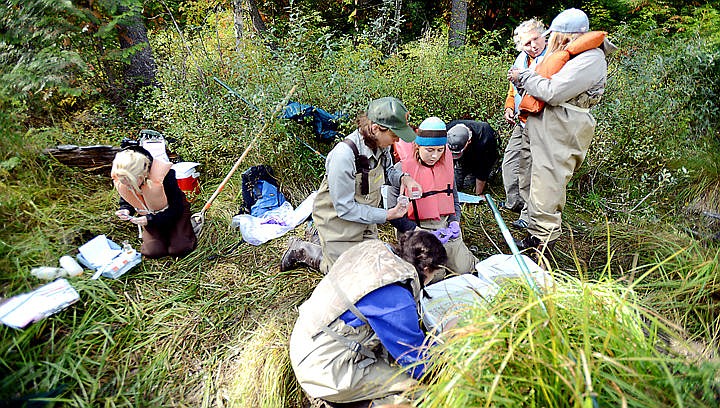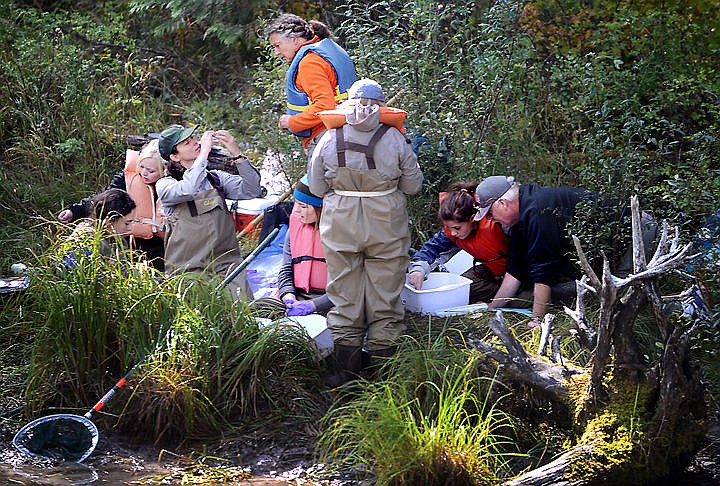Citizens of Science
HILARY MATHESON | Hagadone News Network | UPDATED 11 years, 2 months AGO
Flathead High School science students recently had an interesting job in Glacier National Park: Bagging dragonfly larvae.
The students were on assignment for their International Baccalaureate Environmental Systems and Societies class taught by Lori Ortley and Renee Cordes as part of Glacier National Park’s Citizen Science Program. The mission was collecting data on mercury levels in the larvae, while learning just how detailed study protocols are out in the field.
Under the guidance of a biologist, 35 students spent one field day at two locations in Glacier, identifying and gathering the dragonfly larvae in addition to water and sediment samples for the mercury study.
Similar collection efforts have been conducted by other National Park Citizen Science programs around the United States since 2012 in an effort “to assess the risk of mercury contamination in aquatic ecosystems,” according to the National Park Service.
“We’re looking for a canary in the mine — if there’s a problem with mercury or not,” Ortley said.
Cordes added, “this helps us kind of realize potential future risks for our watershed and it also helps students see where they fit with the rest of the United States, so we can protect it before it’s too damaged.”
Concentrations of mercury can vary from one part of the country to the next for mercury transported by air, according to Ortley.
“We’re one of the northernmost sites, so we have a different weather system,” Ortley said. “You’re looking at jet streams — not just the climate in your little area.”
The samples collected by the Flathead students are being shipped to laboratories in Maine for mercury analysis, specifically methylmercury. The national study will use the data to research the distribution and impact of mercury from power plant emissions, namely coal, according to the National Park Service.
Flathead senior Camas Carlson said methylmercury is the most dangerous kind of mercury to humans and wildlife.
“Mercury is looked at because it bio-accumulates,” Ortley said. “So, once you have some in your system it doesn’t go away.”
Flathead senior Renee Martinez said the dragonfly larvae are a good way to gauge mercury concentrations. Dragonflies spend five years in the larval state, she said.
“The larva is really low on the food chain,” Martinez said. “Fish will eat the larvae and then larger creatures eat them and the mercury builds up [with] bio-magnification. So, when it reaches us it’s at its highest point.”
Although the mercury data won’t be available to this year’s class, students will conduct their own labs using data collected about the environmental conditions where dragonfly larvae were sampled. This is why the teachers had students visit two dissimilar sites. The classes, depending on the day, visited Moose Country Pond, Johns Lake and Quarter Circle Bridge.
“They get to see as ecologists there’s a lot of different factors that affect the organisms they’re looking at,” Cordes said.
Martinez and Carlson described some environmental differences between the Moose Country Pond and Quarter Circle Bridge area from water flow, rockiness versus muddiness and amount of sunlight.
Students had to follow strict protocols when collecting samples and discovered ways to modify sample collection in the future.
“They get to see how challenging it is depending on the field conditions, that it’s difficult to plan for and carry out and experiment perfectly,” Cordes said.
When collecting specimens, students couldn’t touch anything without gloves to prevent contamination, Martinez said.
“There can be mercury that can be on your skin and it could skew the results,” Martinez said.
Carlson was glad she had the opportunity to contribute data to a scientific study that may impact people’s health and the environment. And students were surprised to discover the number of organisms living in the water.
“They don’t realize what’s beneath the surface of the water,” Cordes said.
The Flathead field studies were paid for through grants from the National Park Foundation’s Ticket to Ride program along with Glacier National Park Conservancy, which supports the Glacier National Park Citizen Science program. Flathead Conservation District also provided a grant for the purchase of 10 chest waders.
Reporter Hilary Matheson may be reached at 758-4431 or by email at [email protected].
ARTICLES BY HILARY MATHESON
Whitefish High School wins East Helena speech and debate tournament
Scoring 225 points, the Whitefish High School speech and debate team took first place at a weekend tournament.

Glacier High speech and debate team secures second in Bozeman
The Glacier High School speech and debate team secured second place, and Flathead High School, third in Bozeman.

Heritage Academy expands, moves to new location in Kalispell
Heritage Academy, a hybrid private and homeschool program referred to as a microschool, has moved to a new location, Easthaven Baptist Church, 2010 Whitefish Stage Road in Kalispell.







